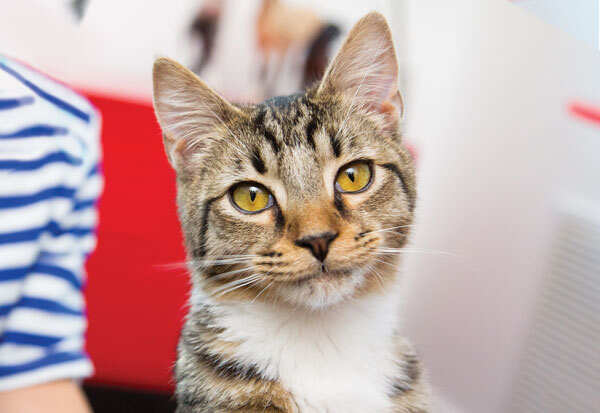
You have decided to get a cat: how to prepare for her appearance in the house
If being a cat owner is new to you, you might be a little scared. Even if this kitten is not your first, having a new pet at home can be exciting and exhausting at the same time. It can be easy to overlook anything you or your kitten may need to make their life more comfortable, especially during their first days and weeks with you. These ten tips will help you make sure your training is successful and you have what it takes to be the best owner for your new pet.
Before she shows up
Before you bring your new furry friend home, prepare your apartment, your family, and yourself so that her transition to a new life is easy.
1. Remove potentially toxic substances.
This is very important for your kitten’s safety. Cats jump, climb, and can crawl into even the smallest cubbyholes, so before you get a cat, carefully inspect all possible places (both above and below) and securely hide anything that could be dangerous. Examples include household cleaners and other chemicals. Don’t forget houseplants – many common plants, including begonias, spathiphyllum, and dracaena, are poisonous to cats, and unfortunately, cats love to eat plants. The American Society for the Prevention of Cruelty to Animals (ASPCA) provides a complete list of plants that are poisonous to cats, but for the safety of both your new cat and your plants, it’s best to move all plants and flowers to a place where she can’t chew on them. .
2. Prepare your home for a cat.
Many cats love to chew on cords and ropes. This not only poses a choking hazard, but the cat can also be electrocuted if it tries to eat the electrical cord. Be sure to hide all power cords, as well as cords from curtains and blinds, yarn, thread and needles, decorative tassels, and anything that might resemble string. Go around the house and check if there are any openings through which she can climb into the duct, into the attic, into the basement, or anywhere else where she could be trapped, and double check if they are securely closed. If you have a dog door, you also need to make sure that the cat cannot use it to escape. The ASPCA recommends installing strong screens on all windows if you don’t already have one, and making sure that trash cans are securely sealed with tight-fitting lids.
3. Talk to your family.
If you have a family, make sure everyone is in agreement about getting a new cat, and decide in advance who will be responsible for feeding and cleaning the litter box. If you have children, set the rules and talk to them about safe ways to play with your cat.
4. Prepare other pets.
If your new cat is not the only pet, you need to plan how you will introduce them to each other. PetMD recommends that you start introducing your new cat to your pets by first giving them a sniff of something they have slept on or interacted with before bringing them into the house. Prepare a small safe space where you can isolate her for the first time, such as a bathroom, so she can calmly adjust to her new surroundings. So she will have a place where she can hide from unwanted attention from other family members.
5. Buy everything you need.
The bare minimum is food and water bowls, a tray and filler. A good cat owner, of course, also wants to make her feel nice and comfortable. To do this, you will need grooming supplies such as a special brush, cat shampoo and nail clippers, various cat toys, and at least one bed. If you want to keep it from climbing on furniture, you’ll probably need a cat bed for every room. You can also install a cat tree so she has a special place to climb in instead of cabinets or tables to satisfy her desire to climb higher. Special posts or platforms will also be a better place where she can sharpen her claws than furniture or carpet.
6. Stock up on quality food.
To avoid stomach problems, it’s best to gradually transition your cat to a new food, so if possible, try to get a week’s supply of the food she was fed by the breeder or shelter, and gradually transition her to the balanced and nutritious cat food of your choice.
First days at home
These tips will help your new cat settle in during the first days and weeks of her arrival, and help you become the best owner she ever wanted.
7. Book an appointment with your veterinarian.
Have a veterinarian examine your cat as soon as possible and give her any necessary vaccinations. He can also help you decide if she should be spayed for various health and safety reasons. If you don’t already have a regular veterinarian, your friends and family members who live in the same area as you can recommend a good one. Remember that after you and your family, your veterinarian is the most important person to your cat’s health and happiness.
8. Buy her a collar with a locket.
Accidents happen no matter how careful you are. If your kitten runs away from you and gets lost, a collar with a locket with your contacts written on it will increase your chances of being reunited. In many shelters, animals are microchipped before they are given to new owners, so it’s worth asking more about this program in case of an unexpected escape of the animal.
9. Start training as soon as possible.
Cats of all ages need to be introduced to house rules, and small kittens and young cats may need to be taught how to use a litter box. Don’t encourage unwanted behavior by interrupting your kitten with loud noises, and give him treats as a reward for good behavior. Try placing strips of tape sticky-side up on furniture and other surfaces your cat shouldn’t scratch, and use catnip to attract her to desired objects like a bed and scratching post.
10. Train her body and mind.
Cats get bored, and a bored cat often becomes naughty. Cat toys will not only keep her entertained and keep her mind busy, but they will also help her stay fit. If possible, make a window seat where the cat can sit and watch birds, squirrels, and people. You can also hide treats and toys throughout the house so she can hone her hunting instincts while getting the exercise she needs.
After all, your new kitty just wants to feel safe and loved, which should be the goal of every cat owner. By doing everything in this article, you can ensure that all of your cat’s basic needs are met, and instead focus on making friends with your new mate.







